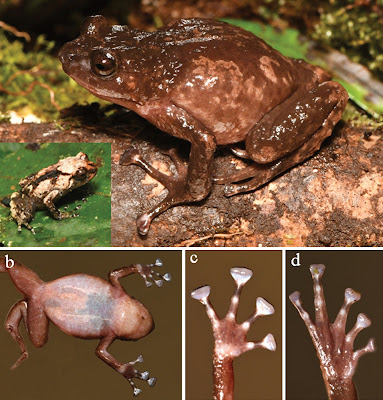 |
| Cophixalus gigiraensis Günther, Dahl & Richards, 2023 Mount Gigira Giant Nursery Frog || DOI: 10.3897/zse.99.97006 |
Abstract
A new arboreal species of the microhylid genus Cophixalus Boettger, 1892 is described from montane rainforest on Papua New Guinea’s central cordillera. With a male SUL exceeding 44.0 mm, the new species is among the largest members of the genus; the only other Papuan species known to reach this size is C. riparius Zweifel, 1962. The new species differs from C. riparius in a small number of mensural characters and by its distinct advertisement call, a single explosive ‘bark’ uttered singly or in rapid series. In contrast, calls of C. riparius recorded near the type locality are a series of drawn out, rasping croaks. Calls of the two species are analysed and compared. The two species also appear to have different ecologies, with the new species found only high in trees, while C. riparius is often encountered in vegetation on or near the forest floor. Examination of osteological features revealed the presence of cartilaginous procoracoids in both species, representing the first records of procoracoids in the speciose genus Cophixalus. Lack of procoracoids is traditionally considered an important diagnostic character for defining Cophixalus but both species also lack clavicles, a character considered diagnostic for Cophixalus and a key feature distinguishing the genus from the closely related Oreophryne Boettger, 1895. Because preliminary published genetic data indicate that they are nested within Cophixalus, we retain both species in that genus until a comprehensive molecular phylogeny of Cophixalus and related genera, particularly Oreophryne, is completed.
Key Words: Amphibia, bioacoustics, central cordillera, montane rainforest, morphology, New Guinea, taxonomy
 |
| Holotype of Cophixalus gigiraensis sp. nov. in life a. Dorsolateral view; b. Ventral view; c. Palmar view of right hand; d. Plantar view of right foot. |
Cophixalus gigiraensis sp. nov.
Mount Gigira Giant Nursery Frog
Oreophryne ? sp. 5 ‘loud grunter’ (Richards & Armstrong, 2017).
Cophixalus sp. 5 ‘loud grunter’ (Richards & Armstrong, 2018).
Cophixalus sp. 4 ‘loud grunter’ (Richards et al., 2021).
Diagnosis: With a snout-urostyle length of 44.4 mm in an adult male the new species is among the largest species of the genus; in New Guinea only Cophixalus riparius reaches a similar size. It is distinguished from C. riparius and all other congeners by the following unique combination of characters: body robust, head short (HL/SUL 0.31); legs moderately short (TL/SUL 0.42), third toe longer than fifth; fingers and toes with greatly expanded triangular terminal discs, all with circum-marginal grooves; discs of fingers much larger than those of toes (T4D/F3D 0.76); dorsal surfaces including rear of tarsus with scattered low tubercles, ventral surfaces smooth; most of dorsal surfaces brown-olive (RAL 8008) with irregular beige (most similar to RAL 1001) flecking; ventral surfaces whitish overlain with moderately dense reddish-brown pigmentation; advertisement call a loud explosive ‘bark’ produced singly or in groups of up to eight, each containing 13–19 pulses lasting 60–80 ms, dominant frequency 1.5 kHz.
Etymology: The specific epithet gigiraensis refers to the type locality of this species, Gigira Ridge, otherwise known as Hides Ridge. Gigira is the local Huli Community’s name for this mountain.
Rainer Günther, Chris Dahl and Stephen J. Richards. 2023. Another Giant Species of the microhylid Frog Genus Cophixalus Boettger, 1892 from the mountains of Papua New Guinea and First Records of procoracoids in the Genus. Zoosystematics and Evolution. 99(1): 173-183. DOI: 10.3897/zse.99.97006

